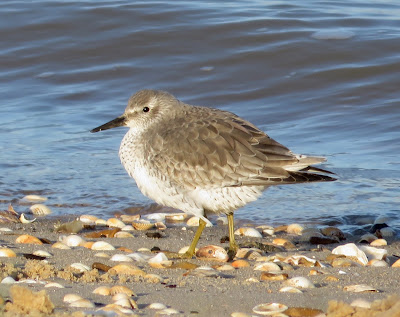There was an eye-catching sunrise from the country park just after 8am on Thursday 29th. After a frosty start to the day, the sun continued to shine, although in some shady places the frost stayed all day.
As the tide came in during the morning, flocks of waders were flying back into the Colne with the most numerous being the dunlin, one pictured above near the East Mersea Point.
Around 500 dunlin were feeding on the mud near the Point, some quite close into the beach.
On mud near Ivy Dock were 200+ avocets, some feeding while others roosted in a group and there was also a flock of 300 golden plover on mudflats off the park.
A pair of red-breasted mergansers flew back into the river and landed near the Pyefleet, also a common seal in the Colne.
On the saltmarsh 2 rock pipits and 4 reed buntings were noted.
On mud near Ivy Dock were 200+ avocets, some feeding while others roosted in a group and there was also a flock of 300 golden plover on mudflats off the park.
A pair of red-breasted mergansers flew back into the river and landed near the Pyefleet, also a common seal in the Colne.
On the saltmarsh 2 rock pipits and 4 reed buntings were noted.
The resident pair of swans with their grown cygnet on the park dyke were having to chase off a second pair of swans from their local patch. This other pair has been visiting on and off for the last week.
A snipe was on the grazing fields and 2 little egrets roosted at the park pond on Thursday.
A flock of 45 white-fronted geese flew south past the car park at the country park at the end of Thursday afternoon. Presumably the same flock seen two hours earlier flying south from Fingringhoe nature reserve by John Thorogood.
A badger was seen first thing in the morning in the daylight near the entrance to the park on Thursday by Sheila Rayner. Her daughter was pleased to see a red squirrel earlier in the week cross the East Mersea road near Church Lane.
A snipe was on the grazing fields and 2 little egrets roosted at the park pond on Thursday.
A flock of 45 white-fronted geese flew south past the car park at the country park at the end of Thursday afternoon. Presumably the same flock seen two hours earlier flying south from Fingringhoe nature reserve by John Thorogood.
A badger was seen first thing in the morning in the daylight near the entrance to the park on Thursday by Sheila Rayner. Her daughter was pleased to see a red squirrel earlier in the week cross the East Mersea road near Church Lane.
There was a nice view of the sun setting along the park beach on Wednesday afternoon with the sun dropping down behind the Bradwell power station.
Earlier in the day on the calm sea, 7 Slavonian grebes, 4 red-throated divers, 150 great crested grebes, 6 common scoter were noted from the park. Feeding along the edge of the mud were 300+ avocets.
Perched alongside the East Mersea road early evening on Wednesday was a barn owl just east of Weir Farm.
The previous day on Tuesday 27th there were 6 Slavonian grebes seen offshore from the park.



















































